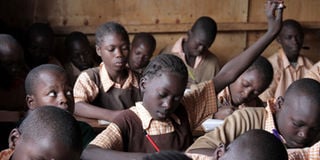Local languages: How minister got it wrong citing 1976 report

Pupils during a lesson. "The country cannot, however, afford there to be losers in education. It needs all of its children to thrive in the classroom. "PHOTO|FILE.
What you need to know:
- What will be the fate of children from minorities condemned to learn in languages in which they have no proficiency?
- And what of teachers working away from their homes? Are they to be replaced by new recruits who speak the approved local language?
Last Monday, Education Cabinet Secretary Jacob Kaimenyi provided us with a reminder of how politics used to be.
In his defiant speech setting out the policy on the use of local languages in the early stages of primary education, Prof Kaimenyi looked and sounded like how Cabinet ministers used to operate in the old constitutional dispensation.
It was not just the tone of Kaimenyi’s speech that seemed outdated. I am no expert in education, but the cabinet secretary’s reference to the findings of the Gachathi Commission of 1976 as support for the use of local languages in primary schools, was an unusual justification for his position.
There are few aspects of Kenyan life today that could be adequately governed with reference to policy formed nearly 40 years ago; least of all education.
Population change, the sheer weight of numbers of children entering school each year, the skills demanded by the modern economy, and the ever-shifting nature of ethnic politics, all point towards the need for a new commission into this question, not the reiteration of the conclusions of the Gachathi Commission.
This is not to suggest that Kaimenyi’s position is entirely unreasonable. To the layman at least, the insistence that the very youngest children will learn best in their own language seems, at first glance, sensible. And as he argued, evidence from other developing countries is that this strategy delivers results.
PROTECTING CULTURE
Moreover, education in local languages is one way of protecting culture, literature and history that may otherwise be lost. Ngugi wa Thiong’o has long demonstrated the fertility of the soil of Kenya’s vernaculars.
But the nature of everyday life in Kenya provides particular challenges to these theories. Over the past two decades, there has been no more politically important question than to ask ‘who is local?’ This question is most loaded in the places where it is most difficult to answer.
We all know that Kenya is not a jigsaw puzzle made up of distinct ethnic groups. Instead, it is an amalgamation of cosmopolitan counties. That diversity has produced conflict, but much more commonly, it has demanded cooperation as citizens get on with their ordinary lives.
Like so much else to do with identity in modern Kenya, language has been adapted and changed to fit the multi-ethnic realities of everyday life. Kaimenyi’s insistence that a local language can be determined in any school’s catchment area is striking, therefore.
What will be the fate of children from minorities condemned to learn in languages in which they have no proficiency? And what of teachers working away from their homes? Are they to be replaced by new recruits who speak the approved local language?
The main aim of Kaimenyi’s policy statement seems to have been to sate demands for the greater representation of local communities in the education system without ceding control of schools to the counties; governors are determined to add schooling to their portfolios and so seize control of the education budget.
Whatever the outcome of this particular struggle, the direction of travel in education seems to be away from nationalist educational policies.
EXACERBATE DIVISIONS
Whether through Kaimenyi’s policy or by the transfer of responsibility for education to the counties, education seems set to become ever more local in its focus.
In some places, with enlightened leadership, this trend will have positive effects. It may encourage ethnic cooperation and give children the skills necessary to thrive in later years. But in other locations, an education system with greater local influence will probably exacerbate divisions and marginalize children from minorities.
As this education debate suggests, the trends towards greater and greater decentralisation in all walks of life is unmistakable.
For all the battles in parliament and in the courts over devolution, even policy areas reserved for central government, like education and law and order, are being given a local feel.
This is resulting in huge variations from county to county as different governors and assemblies adopt different policies and exhibit vast variations in competency.
Trying to capture the reality of the new Kenya is a real challenge for commentators in the media, policy makers in government and academics.
The country has never seemed so complex and its constituent parts so important. Single, simple narratives—development, growth, poverty, inequality, democratisation, authoritarianism—are no longer enough to explain what’s taking place from county to county as devolution creates different winners and losers in each county.
The country cannot, however, afford there to be losers in education. It needs all of its children to thrive in the classroom.
Kenya in 2014 is a profoundly different place than it was in 1976 and it needs an education policy to match.





